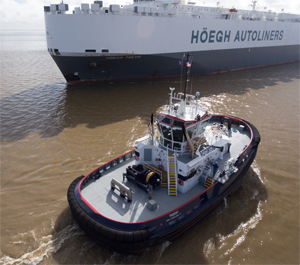Tug Use in Port – A Practical Guide
Third Edition, 2018
by Capt. Henk Hensen
The ABR Company Ltd., Wiltshire, United Kingdom
Ship handling with tugboats is an art created through science. Tug Use in Port by Capt. Henk Hensen explains the scientific foundation of the intricate ballet resulting from the concerted interaction of the pilot and tug master and their charges.
This latest enhancement of Hensen’s work bridges the years since 2002 when the second edition of this industry standard was published. During the intervening years there have been numerous advances in tug design, tug usage in ship docking and escorting, and tug and ship-handling training methods, as well as increased safety regulation and oversight. In his third edition, Hensen addresses these advances and changes in both a scientific and practical manner for their operational application. The subtitle of the book, “A Practical Guide,” is apt.
In addition to pilots and tug masters, Tug Use in Port will be useful to tug company and port authority personnel in their decision-making processes regarding the protection of infrastructure and risk minimization.
In 2002 in the United States, tractor tugs — generally azimuthing stern drive or ASD tugs — were just beginning to appear more broadly for ship assist. Since then, tractor tugs have become commonly used in most ports. In addition to tractor tugs, we now have ship docking module (SDM) tugs, Z-Tech tugs and Rotortugs on the U.S. ship-handling canvas. Looking to the future, we eagerly await the appearance of the reverse stern drive (RSD) tug with its enhanced capabilities through the incorporation of several attributes of the other modern tug types. Hensen provides the reader with a detailed description of this new innovative tug, one of which has recently been visiting various European ports and engaging in practical demonstrations.
Chapter 2, “Types of Harbor Tug,” has been significantly expanded with descriptions of builds and uses of tug types that have evolved in recent years, and the practical knowledge and descriptions of the uses of “traditional” tugs. Numerous photographs and diagrams depicting creative and evolving ship-handling techniques are of significant interest; for example, center lead aft and center lead forward maneuvers and variations thereof are now quite common in handling “ultra-large” vessels of all persuasions calling in our ports. The discussion of dangerous operational situations provides a common-sense reminder that the tug is not an inanimate object, and that the tug crews trust the shiphandler to exercise the utmost concern for their safety.
 |
|
Seabulk Towing’s Trident was the first Rotortug to be put into service in the United States, reflecting the continuing adoption of new tugboat technology on this side of the Atlantic. Trident is shown alongside the vehicle carrier Hoegh Tokyo in the Port of Mobile, Ala., in 2017. |
|
Courtesy Seabulk Towing |
In this regard, Hensen has expanded the discussion in Chapter 8, “Training,” to include improved methods of training by simulator, artificial reality, manned models and specialized tugs.
The new edition of Tug Use in Port adds Chapter 11, “Balancing Safety,” which is devoted to the safety aspects of tug usage that pilots, tug masters and corporate personnel will appreciate. This section includes discussion of the recently enacted regulations of Subchapter M for U.S.-flag vessels. In this noteworthy addition, Hensen pens a common-sense perspective to safety. He provides, again, a scientific basis for risk assessment, and discusses “actors and factors” that all experienced pilots, tug masters and ship masters intuitively consider (or certainly should consider) prior to and throughout every maneuver with tugs.
In this third edition, the reader also is reminded of the new challenges presented by the classes of vessels now routinely calling in ports around the world — ULCV, LNG, etc. — and the environmental safeguarding capabilities mandated for pilots, tug masters and tug designers.
As high winds will always pummel the ever-increasing sail area of ships, the tutelage in Chapter 5, “Bollard Pull Required,” remains required reading for safe maneuvering. Both large sail area and high-displacement movement scenarios are addressed in detail. The author clearly sets forth the underlying science of the shiphandler’s decision for tug type and use in such maneuvers. This reviewer has long found the information herein most accurate.
Hensen deftly balances the highly technical aspects of tug design, history and modern development with the practical uses and capabilities that have been achieved. As a result, both experienced ship and tug handlers and technical aficionados benefit from his work.
The third edition of Tug Use in Port, being recommended by the International Maritime Organization, will earn a position of prominence in the professional libraries of all who are routinely involved with the interactive maneuvering of tugs and ships.
Capt. John C. Traut is a member of the Baltimore-based Association of Maryland Pilots.

